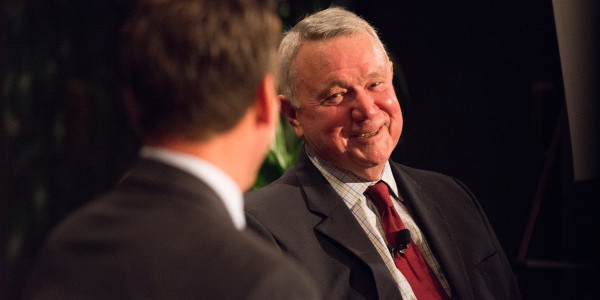
By Elizabeth McGuire
Former Mayor Lee Leffingwell is the rare breed of native Austinite who doesn’t pine for the good old days. Instead he embraces the growth and changes of his hometown and seems to keep the big (and increasingly bigger) picture in mind.
Born and raised in the Bouldin Creek neighborhood, Leffingwell graduated from the University of Texas with a mechanical engineering degree, then spent most of his career as a pilot with the U.S. Navy and later for commercial airlines.
Beginning in 2005, Leffingwell served for six years on the Austin City Council then four years as mayor of Austin. He is known as a politician who helped to strengthen Austin’s economy and lead the city through pivotal civic infrastructure projects.
Now retired, Leffingwell remains heavily involved in the Austin community. On May 8th he will be honored with the Polly Scallorn Community Trustee Award at Leadership Austin’s 2015 Best Party Ever sponsored by H-E-B.
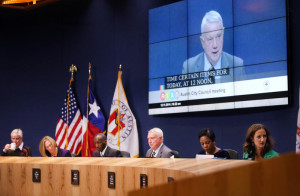 Before getting into politics, you were a military and commercial pilot. Have there been common denominators throughout your career?
Before getting into politics, you were a military and commercial pilot. Have there been common denominators throughout your career?
There were different types of leadership involved. I spent a total of 20 years in the Navy and retired as a senior officer. There was lots of leadership opportunity and you see many styles of leadership. Of course in the Navy you have more options. You could try to lead in one way, but at the end of the day there’s always the option of brute force. And that is not always available in the civilian world (laughs).
As a captain on an airline, I learned over the years that I got a lot more out of it by deferring more. I understood that the crew knew better the specifics of their job and I should let them do it.
Going into politics, you quickly learn that you aren’t going to boss those people around.
You served on the city council and as mayor. Did your leadership style change after you had been in office for a while?
There were shades of difference. There are times when you have to be a little forceful but in a more subtle way. For example, I was always big on starting meetings on time. That’s not something that a lot of people are used to. I’m not going to go back, banging on the table, and say “You gotta get here on time!” Instead, as soon as I got a quorum of four people I would start. People were up in their offices and their aides would see the meetings on TV and say, “They’re starting down there!”
Did working with so many differing opinions come naturally to you or was it a learned skill?
Definitely a learned skill because we all start out in a silo–from childhood.
I was born and raised in Austin and spent most of my life here, but I didn’t really know Austin until I ran for public office.
You have to get out and meet all kinds of different people. For example, there’s a very large and growing Asian American community here that I’m now very close to, but I didn’t know they existed before. The diversity in Austin is something we ought to value, and at same time, that diversity has to collaborate and work together. It’s important to participate in your community and culture but also get involved in your city as a whole.
What’s the most rewarding part of your work?
Actually making progress on things that matter to the city. A lot of it is very difficult. If you’ve been around this town very long you know that almost everything is controversial. You have to bring a lot of diverse opinions together and try to find the points of agreement so you can make progress. One thing I’ve learned over the years in politics is that all proposals are complex to varying degrees. As a piece of legislation begins to work it’s way through…you have to make changes and compromise to get other people on board.
What surprised you about being mayor?
The workload. And everybody who gets into it is surprised by that. I had the advantage of being on the city council for four years before I was mayor, and it still surprised me. You’ve not only got the job of trying to make some progress on issues that are important to the city, but you have to be the face of the city. And everybody, everybody wants you to be at their ribbon cutting, their ground-breaking, their celebration. And it adds tremendously to your workload. It was seven days a week most of the time.
What are you hopes for Austin as we begin this new era of 10-1 government?
Well I think it’s a big change. I supported geographic representation when I first ran for city council, and there are pros and cons. I actually ended up supporting a hybrid system, where you have some geographical representation and some at-large districts. I initially proposed 6 districts with 2 at-large and a mayor. I finally compromised and proposed an 8-1 system. And of course we now have a 10-1 system. I think it’s going to have some problems that they will need to work out as they go through the process.
It will be a sad thing if we end up building 10 fiefdoms around the city and everybody’s looking out for their home turf. It’s hard to keep the community as a whole, and to keep their interests in mind. In fact, I would go even further and say that one of the most difficult things to get across is that now we have to think more regionally. It’s more than just the city of Austin. It’s the entire 6-county region we have to be concerned about.
You joined the Essential Class of 2005? What drew you to it?
When I started to think about running for city council, of course you talk to a lot of people in the community, and I met so many people who said, “This is something you ought to do.” I knew it would be a good learning experience and build networking opportunities around the city.
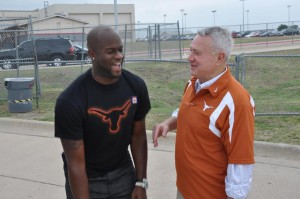 What lessons/experiences from Leadership Austin have stuck with you?
What lessons/experiences from Leadership Austin have stuck with you?
Again, it’s a need to work across the silos, the lines and the divisions. It’s also an experience in diversity. Leadership Austin introduces you to a whole new group of people. The program is designed to take you through a lot of different parts of the city, with a new issue every month or a new part of the community every month. I think it’s a great broadening experience.
Any advice for emerging Austin leaders?
I don’t know if I’m coining a term here or not, but it’s important to think about inclusive diversity: bringing diverse groups of people with different interests together to work for common goals. That’s what community leadership is all about.
Advice for established leaders?
You have to realize you are going to continue to evolve over the years, and whatever your general philosophy of leadership and collaboration is, there are going to be tweaks to those along the way. You’ve got to be willing to make them.
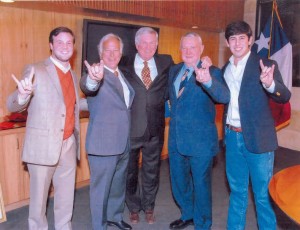 You grew up in Austin. What’s your favorite thing about the city?
You grew up in Austin. What’s your favorite thing about the city?
Of course I’m very proud of Austin. And I’m a growth proponent. I think Austin has grown into a much different city than it was when I was a kid, while at the same time maintaining the idea that “we are a large city with a small town culture.”
We went through this period where we were a super young city. Now we’re the number one city in the country for Baby Boomers. Retired folks are coming back to the city to live. Not to get a great job, but just to enjoy the ambiance of the city.
What do you think Austin needs right now as a community?
I was a big proponent of the failed rail proposition in the 2014 election. If we don’t address that problem then we’re going to be in trouble. We’re going to begin to see the effects of it. We’re not going to be as attractive of a city. We’re seeing that now: the growth in the suburbs around the city of Austin is bigger than in the city.
People talk all the time about the cost of living. To put it in perspective, among larger successful cities around the country, we’re actually doing pretty good. At the same time, we have to work every day to make sure we, as far as government goes, keep that as affordable as we can.
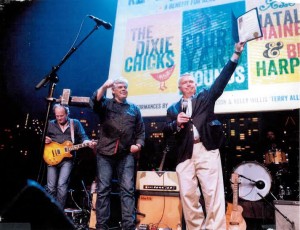 What ways are you still involved in the community?
What ways are you still involved in the community?
Disengagement is not as easy as you might think. You don’t just walk away. I’ve made a point not to offer unsolicited advice to people, although I do talk to the mayor occasionally. We have rambling conversations…about the nuts and bolts and who to talk to about this or that. I still occasionally get invited to events. The Austin Chamber named me Austinite of the Year in January, and I was really proud of that. I’ve been asked to be on the advisory board of Greater Austin Asian Chamber of Commerce and the Austin Police Association’s “Cops for Charity” program. I said from the beginning that I wouldn’t get on too many boards right away, but these were two groups I had to say yes to.
How did you feel about receiving Leadership Austin’s award?
I was kind of floored. I consider that to be a special honor from a group of people who study people in leadership positions. So many people I’ve dealt with over the years and so many people on my staff have been through this program. I still run into people that I was in class with and it’s like a “long lost buddy.” We have an immediate connection. It’s an honor to be recognized by Leadership Austin.
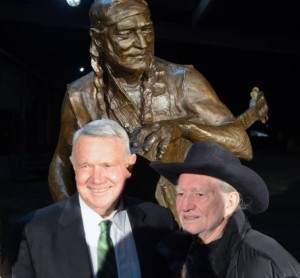 Anything else you would like to share?
Anything else you would like to share?
City government is basically where the rubber meets the road–where the elected officials meet the people. We’re on the floor together. If you go down to the capitol, in Austin or Washington, when the decisions are being made, the public is up in the gallery. At the city level, you’re much more involved with the people affected by what you do.
We do have an intense citizen involvement process and people will come down and fill up that chamber (it seats about 200), and they will be boisterous sometimes and very passionate about whatever it is we’re dealing with. You have to see through that sometimes. You hear them, but you also realize that there are 800,000 other people in this city who are also affected by our decisions. You can’t be totally swayed by what you see on the floor. Pay attention to it, but it’s not necessarily the position of most of the people in the city. You have to keep in mind the other 800,000 people when you’re doing your job.
